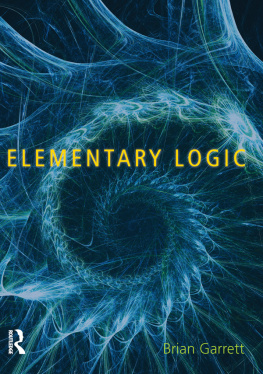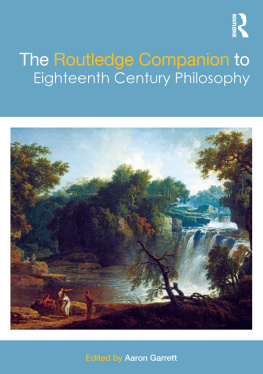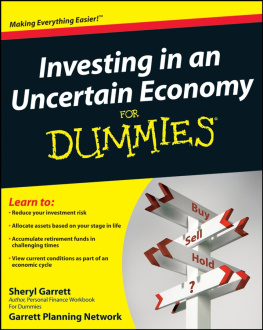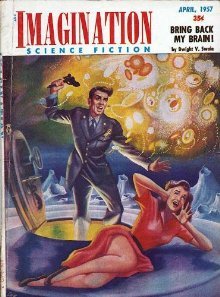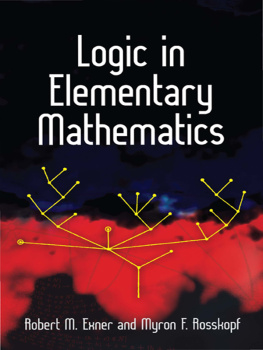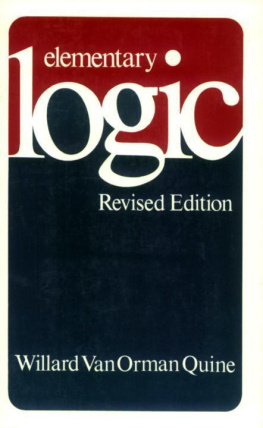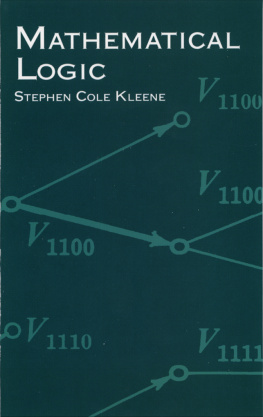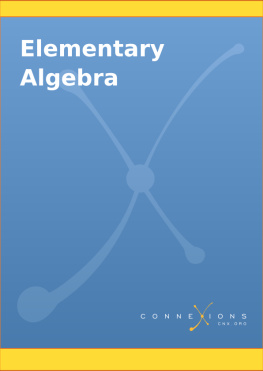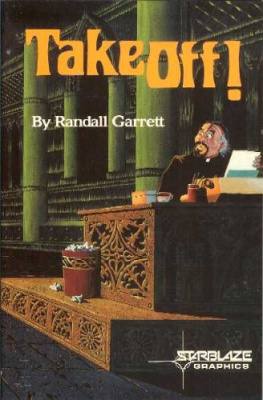Garrett - Elementary Logic
Here you can read online Garrett - Elementary Logic full text of the book (entire story) in english for free. Download pdf and epub, get meaning, cover and reviews about this ebook. publisher: Taylor & Francis (CAM), genre: Children. Description of the work, (preface) as well as reviews are available. Best literature library LitArk.com created for fans of good reading and offers a wide selection of genres:
Romance novel
Science fiction
Adventure
Detective
Science
History
Home and family
Prose
Art
Politics
Computer
Non-fiction
Religion
Business
Children
Humor
Choose a favorite category and find really read worthwhile books. Enjoy immersion in the world of imagination, feel the emotions of the characters or learn something new for yourself, make an fascinating discovery.
Elementary Logic: summary, description and annotation
We offer to read an annotation, description, summary or preface (depends on what the author of the book "Elementary Logic" wrote himself). If you haven't found the necessary information about the book — write in the comments, we will try to find it.
Elementary Logic — read online for free the complete book (whole text) full work
Below is the text of the book, divided by pages. System saving the place of the last page read, allows you to conveniently read the book "Elementary Logic" online for free, without having to search again every time where you left off. Put a bookmark, and you can go to the page where you finished reading at any time.
Font size:
Interval:
Bookmark:
First published 2012 by Acumen
Published 2014 by Routledge
2 Park Square, Milton Park, Abingdon, Oxon OX14 4RN
711 Third Avenue, New York, NY 10017, USA
Routledge is an imprint of the Taylor & Francis Group, an informa business
Brian Garrett, 2012
This book is copyright under the Berne Convention.
No reproduction without permission.
All rights reserved. No part of this book may be reprinted or reproduced or utilised in any form or by any electronic, mechanical, or other means, now known or hereafter invented, including photocopying and recording, or in any information storage or retrieval system, without permission in writing from the publishers.
Notices
Practitioners and researchers must always rely on their own experience and knowledge in evaluating and using any information, methods, compounds, or experiments described herein. In using such information or methods they should be mindful of their own safety and the safety of others, including parties for whom they have a professional responsibility.
To the fullest extent of the law, neither the Publisher nor the authors, contributors, or editors, assume any liability for any injury and/or damage to persons or property as a matter of products liability, negligence or otherwise, or from any use or operation of any methods, products, instructions, or ideas contained in the material herein.
Isbn: 978-1-84465-517-5 (hardcover)
Isbn: 978-1-84465-518-2 (paperback)
British Library Cataloguing-in-Publication Data
A catalogue record for this book is available from the British Library.
Designed and typeset in Minion Pro.
The book offers a clear and concise introduction to propositional logic. It can be used in a three-month course, but also could be expanded for use in a longer course. The last two chapters contain philosophical material, which should be accessible even to beginning students.
My aim has been to produce a logic text that offers a concise, ground-up introduction to elementary logic, with an emphasis on the ideas underlying logical principles and rules of inference. I am writing for the student who wants to understand the basic ideas of elementary logic, but may have no intention of doing more advanced work in logic. My concern is to get students to see why a given proof is valid or what the rationale is for a particular rule of inference. Such insights are of more value than being able to zip through proofs in record time. To that end, are given up to answering some of the questions at the end of preceding chapters with, quite deliberately, much in the way of authorial intervention.
Since the target audience is philosophy students, I thought it might be useful to look at various meta-logical or philosophical issues that arise from propositional logic, and outline more advanced logics that some students might like to investigate further. It is well for students to know, for example, that the classical logic that underpins elementary logic has counter-intuitive aspects, and that there are rival systems of logic. Such reflections make it apparent that logic and the philosophy of logic cannot be cleanly separated. These issues are discussed in .
In . Since paradoxes matter, logic matters too.
Three further features of the book are worth noting: the concept boxes, the Glossary and the Further Reading section. In many of the chapters I have interspersed the text with concept boxes. These boxes either summarize some concept or technique central to a given chapter or else further elaborate on some claim made therein. In the Glossary I give clear and explicit definitions of many of the key words and phrases used in the book. Key words or phrases in the text are indicated using bold toning on first appearance. A firm grasp of the terms that appear in the Glossary is crucial to understanding the nature of logic and logical truth. As well as the articles and books referred to in the text and footnotes, I have selected a number of useful and interesting books and articles for the Further Reading. These readings are themselves divided into various subsections, making it easy for the student to follow up any particular topic.
Some are sceptical of the value of teaching students elementary logic. I am not. Many arguments in philosophy and elsewhere are fallacious, and we need logic to expose them. Even if many philosophical debates turn on the truth or falsity of premises, rather than the validity of arguments, it is still important to be able to identify the form of argument in question. In addition, it is undeniable that competency in logic, like any intellectual skill, helps to sharpen and perfect the mind. A student trained in logic will be better placed to assess and evaluate any piece of reasoning they come across, in philosophy or in real life.
This book has grown out of a short Introduction to Logic course that I teach at the Australian National University (ANU). Thanks to various students in my logic classes over the years for their helpful comments. I am also grateful to three anonymous Acumen referees, and to Peter Eldridge-Smith, Katrina Hutchison, J. J. Joaquin, Thomas Mautner, Peter Roeper and Ryan Young for useful feedback.
The aim of this book is to introduce students to the ideas and techniques of symbolic logic. Logic is the study of arguments. After working through this book the reader should be in a position to identify and evaluate a wide range of arguments.
Once an argument has been identified, we need to determine whether it is a good argument or a bad one. By good argument we mean a valid argument; by bad argument we mean an invalid argument. Our primary method for determining validity will be , but we also use the (simpler but more cumbersome) method of truth-trees. In addition, we briefly show how truth-tables can also be used to test for validity.
Elementary logic studies arguments, and, in doing so, it studies the logical or inferential properties of the so-called logical connectives: and, if then , or, not and if and only if. We use these logical words much of the time, even if we might find it hard to say what they mean. In logic, however, these key words have a clear and explicit meaning.
In elementary logic, the premises and conclusion of an argument are all declarative sentences; that is, they are sentences that are either true or false. There are only two truth-values and each declarative sentence has one and only one of them. The cat is on the mat, no one loves Raymond and all bachelors are bald are examples of declarative sentences.
Is the cat on the mat?, Put the cat on the mat!, Dont park there and I pronounce you man and wife are examples of non-declarative sentences. It would be odd to respond to utterances of any of these four sentences with Thats true! (or Thats false!). In these latter cases, the utterer is not stating or asserting things to be a certain way (so that things would either be that way or not).
As noted, we are concerned with five logical connectives: and, if then , or, not and if and only if. These connectives are used to form new sentences. Thus, from the sentences Bill is bald and Fred is fat we can use and to form the sentence Bill is bald and Fred is fat. We can use if then to form the sentence if Bill is bald then Fred is fat. And so on with the other connectives. (Note that all the connectives except not take two sentences in order to form a new sentence. Not takes only one.)
The logical connectives are thus ).
The meaning of the logical connectives is captured not only by their truth-tables, but also by the rules of inference associated with each connective. Thus, for example, and is associated with the rules: from A and B infer the conjunction A and B; from A and B infer A (or infer B).
Font size:
Interval:
Bookmark:
Similar books «Elementary Logic»
Look at similar books to Elementary Logic. We have selected literature similar in name and meaning in the hope of providing readers with more options to find new, interesting, not yet read works.
Discussion, reviews of the book Elementary Logic and just readers' own opinions. Leave your comments, write what you think about the work, its meaning or the main characters. Specify what exactly you liked and what you didn't like, and why you think so.

